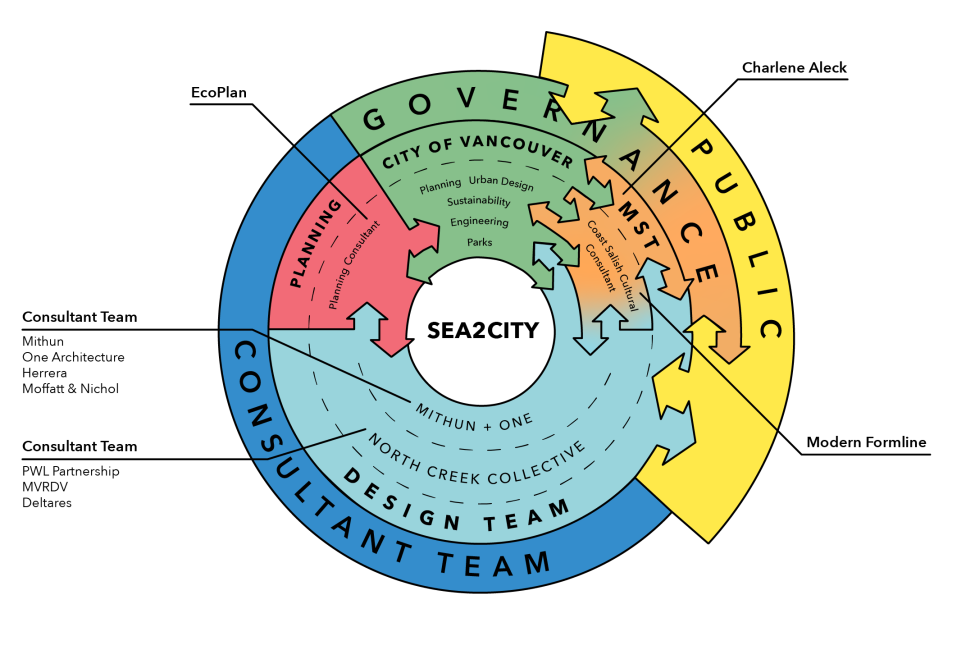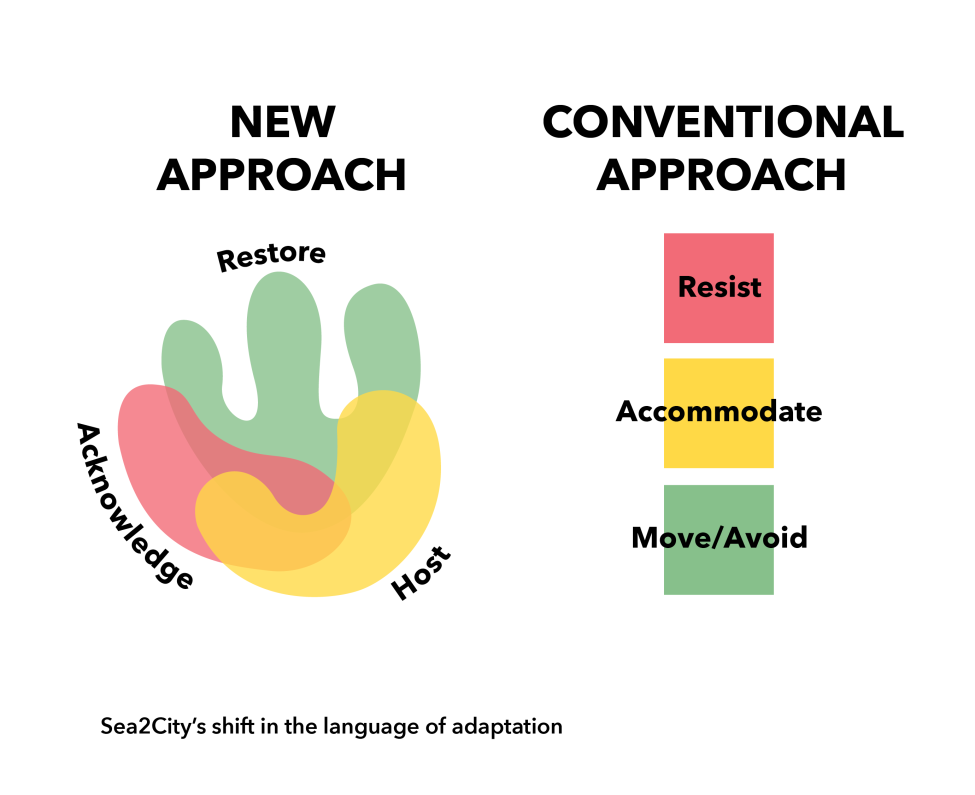Sea2City was a year-long, innovative project that facilitated a uniquely collaborative and iterative process that engaged diverse participants in reimagining the future of False Creek waterfront in response to rising sea levels. This design challenge, Led by PWL Partnership and Mithun, the two distinct teams—North Creek Collective and Mithun + One—have forged a path that rewrites traditional design boundaries, reshaping the blueprint for future adaptation work in Vancouver and beyond.
The project was characterized by workshops, community events, and design deliverables. It showcased the pivotal role of landscape architects in fostering collaboration across disciplines and between practitioners and the public. By centring decolonization in its approach, the project has influenced future Coast Adaptation efforts and spurred pilot projects to test ideas. The result is not a final solution but rather a renewed approach and deeper understanding of the relationships and connections that sustain us—and how this knowledge might be applied to help tackle the complex challenges ahead. Two design teams collaborated at crucial junctures throughout the project's timeline. Their collaboration involved converging to synthesize ideas and then diverging to individually craft materials and reports tailored for a unique site and a wide and diverse audience. Sea2City signifies a shift and offers precedent towards comprehensive, community-driven design approaches with implications beyond its immediate scope, showcasing landscape architecture's lead role in creating resilient, inclusive, and sustainable urban environments.
Community Engagement Events & Workshops
- Community engagement included workshops to solicit feedback from the Community Advisory Group and Youth Adaptation Lab, groups assembled by the City for the Sea2City challenge. Additional public engagement events were conducted throughout the process by the City. The resulting information was incorporated into the design teams’ work.
- Internal in-person two-day workshops (dubbed ‘collaboratoriums’) were held throughout the project. These events included all members of the design team and allowed for rapid ideation and design progress, as well as site exploration and face-to-face relationship building.
- A collaborative site plan for the East of Cambie site was developed during a one-day design charette that included both design teams, the Technical Advisory Group, and City staff.
- Throughout the project, communication between teams was regular, allowing both to align and strengthen the project’s assumptions and values, particularly in light of the Renewed Approach.
Communication Materials
- The Sea2City design teams produced materials that were publicly available on the City of Vancouver’s Sea2City website and were promoted via City social media. Video content was developed by the City of Vancouver to be featured on the project website. Design team members were also interviewed on CBC radio and TV.
Final Report
- The final Sea2City Design and Costing Brief describes a renewed approach and deeper understanding of the relationships and connections that sustain us—and how this knowledge might be applied to help tackle the complex challenges we’re facing.
- The report is a summary of key outcomes and recommendations intended to guide future work and approaches to sea level rise in False Creek. It includes a Planning and Design Brief, outlining the concept designs for the project sites along with key considerations and future design recommendations; Integrated Flood Management, including high level approach and the flood management ribbon as applied to the project sites; an adaptive design brief, providing values-based guidance on decision-making in a 2m+ sea level rise scenario; and a series of pilot projects for immediate implementation along with high-level costing. These projects range from highly innovative and technical to “quick-start” interventions to boost biodiversity.
Key Challenges Faced
The project's triumphs and trials were intricately woven into its efforts to effectively communicate the complexities and possibilities inherent in a transforming waterfront, with a particular focus on decolonization.
- Establishing a design approach that responds to the need for coordination and cooperation between many different jurisdictions and agencies towards a shared goal.
- The Design Teams were challenged to rethink our conventional approaches (resist, accommodate, avoid/move) to sea level rise and the underlying relationships and values. As the project unfolded, with the help of Knowledge Keeper Charlene Aleck, the parameters of the project shifted to respond to a renewed approach to sea level rise that is rooted in a relationship of respect and reciprocity with the lands and waters.
- Coordination with our project partners across time zones and continents challenged our team to develop strategies for collaboration and coordination across multiple time zones and continents. Project team members from overseas were challenged to become familiar with the cultural, historical, and ecological context of Vancouver, False Creek, and the Salish Sea. Perhaps most importantly, international team members were challenged to deeply understand the relationship of the Host Nations to the lands and waters and our responsibility as designers to honour and uplift these relationships. Our international team members brought fresh eyes, new ideas, and solutions from their own communities to bear on this local context, with its opportunities and challenges.
Community Engagement and Connection
The project connected with over 2,000 community members, advisory group members, collaborators, students, and members of the public directly, and reached 160,000 people across social media platforms. Sea2City provided a collective learning and capacity-building opportunity for the City of Vancouver, project partners, and the design teams to increase public awareness of sea-level rise and coastal flooding and opportunities to address it.
The Challenge included three rounds of events and activities. Each round included public learning and design events, as well as advisory sessions and workshops with groups established for the project.
Solution / Approach
Our innovative project approach resulted in a diverse range of deliverables that captured the attention of practitioners and the public alike. It served as a testament to the resilience and adaptability of landscape architects, showcasing that a project is never truly "finished" but rather an ongoing process that evolves with the changing needs of the environment and the community it serves. The outcome of Sea2City did not offer a definitive solution but instead presented a framework that addresses the dynamic challenges faced by urban waterfronts.
The project's successes and challenges were intricately woven into its efforts to effectively communicate the complexities and possibilities inherent in a transforming waterfront, with a specific focus on decolonization.
Lessons Learned
Our team has reflected on the incredible experience, the privilege of working on this project and the lessons we learned.
Language Shapes Design.
- Choosing the right words is crucial in addressing sea level rise in Vancouver's False Creek Basin. Charlene Aleck, the project's Indigenous Knowledge Holder from the Tsleil-Waututh Nation, emphasized how language can influence our understanding and solutions. By reframing terminology to align with Indigenous values, the project team reimagined their design approach, enriching their perspectives and shaping their early design decisions.
Understand the Past, Present, and Future.
- Sea2City focused on addressing sea level rise in Vancouver's False Creek Basin, guided by Charlene Aleck's insight. Understanding our climate emergency requires acknowledging our history, challenges, and necessary actions. This commitment to decolonization is essential for creating a sustainable and inclusive future for False Creek.
Pause for Reflection in Urgent Times.
- Despite the urgency of climate change, Sea2City taught us the importance of slowing down to avoid reactive responses. Taking time to engage with diverse perspectives outside our usual environment sparked valuable insights and enhanced our ability to respond thoughtfully and effectively.
Prioritize Natural Floodplains.
- Floodplains, if preserved, can mitigate flooding by storing and slowing water movement. Human interventions disrupt this natural function and create new risks. Recognizing and restoring natural systems, as emphasized by Sea2City, is crucial for long-term, resilient flood management.
Embrace Exploration and Experimentation.
- To achieve long-term goals, we must be willing to take immediate action. Pilot projects can test innovative technologies or nature-based solutions, fostering collective action and paving the way for future urban ecologies in False Creek.
Results and Impact
The Sea2City Design Challenge was a 12-month collaborative initiative focused on reimagining Vancouver's False Creek shoreline. It brought together diverse design teams, City staff, coastal adaptation experts, and representatives from Musqueam, Squamish, and Tsleil-Waututh Nations. The project aimed to address rising sea levels, urban development, and ecological revitalization, contributing to the City’s Climate and Coastal Adaptation Plans with a focus on decolonization.
The Project Outcome Summary comprises the Final Reports of two design teams and collaborative event materials. Each report includes details about site-specific integrated flood management approaches, adaptive design and costing. The Collaboratorium document features the public open house boards.
Key Considerations of Reports
- Focus on Vulnerable Sites: Sea2City focused on sites vulnerable to sea level rise, integrating community values, Indigenous knowledge, and design principles.
- Collaborative Approach: The initiative employed a multidisciplinary approach involving diverse participants.
- Public Awareness and Reconciliation: Sea2City aimed to raise public awareness about sea level rise and coastal flooding while centering reconciliation with Host Nations in coastal adaptation efforts.
- Addressing Challenges: The reports aimed to address social equity, economic, and ecological challenges posed by sea level rise, considering potential scenarios with a rise of at least two meters.
- Generational and Knowledge-Intensive Approach: Team approach that emphasized a generational, knowledge-intensive project grounded in decolonization, involving Host Nation representatives, knowledge keepers, cultural advisors, and artists in the design process.
- Vision and Approach Development: The design teams developed a Vision and a new approach to coastal adaptation for Vancouver, influencing designs and pilot projects.
- Reflective Learning and Collaboration: The intentional organization fostered inter-team collaboration and embraced a reflective learning approach.
- Piloting Responses: The City of Vancouver is now piloting Sea2City outcomes on test sites, indicating a practical application of the project's findings.
The project demonstrated a commitment to a long-term vision created for the vulnerable urban waterfront. It was a collaborative, iterative, and cumulative effort focused on exploring visions and possibilities for the waterfront. The decolonized vision for False Creek reframes the City’s relationship with the shoreline, its processes, and inhabitants.
Legacy and Future
The City of Vancouver, in partnership with members of the Challenge’s design team, are piloting the first outcomes of Sea2City on a test site. This practical application will allow for the evaluation of the feasibility, impact, and scalability of the proposed strategies before broader implementation. The piloting phase represents a crucial step in the project's progression, moving from theoretical concepts to real-world implementation and assessment. It demonstrates a commitment to evidence-based decision-making and a proactive approach to addressing the complex challenges posed by climate change and urban development in coastal areas.
In the long term, the project resulted in recommendations for the creation of flood-adaptive design guidelines for waterfronts and buildings, local shoreline environmental assessments, consideration for a shoreline resilience land usage zone that would support phased and incremental changes, a stewardship plan for the area to ensure long-term management, False Creek and creative approaches to secure funding.
Awards
2024
Canadian Society of Landscape Architects (CSLA) Jury's Award of Excellence
Canadian Society of Landscape Architects (CSLA) National Award — Communication
Project Team
Internal
- Derek Lee
- Sophie MacNeill
- D'Arcy Hutton
- Beau Wuthrich
- Meredith Wilson
External
- Charlene Aleck
- Modern Formline Design
- MVRDV
- Deltares
- Happy Cities
- Westmar Advisors
- GW Williams Associates Ltd.
- Goudappel
- Modus
Resources
Learn more about the Sea2City Design Challenge on the City of Vancouver website.

















